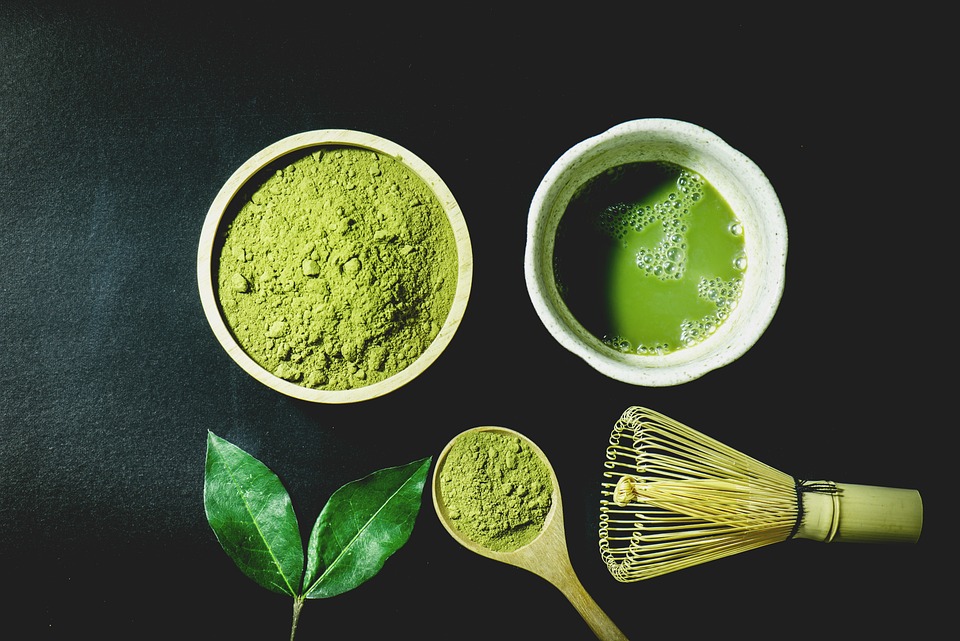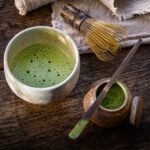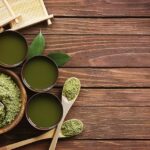How Is Matcha Tea Different from Regular Green Tea?
According to research, green tea is the most healthful of all teas. But what makes matcha special?
The matcha process begins when the green tea leaves are still growing. The plants are shaded a few weeks before harvesting to increase chlorophyll and amino acid content (particularly L-theanine), and to improve the appearance and flavor of the tea. This gives matcha powder its brilliant green color.
After the leaves are harvested, they are steamed, dried, and blended. Then, they are ground into a fine powder which can be mixed into hot or cold water.
The result? You’re actually drinking the entire tea leaf! traditional green tea only contains the parts of the leaves that dissolve in water
This means that matcha powder can provide you with more health benefits than green tea. A cup of matcha tea has about three times the antioxidants of regular green tea.
What Does Matcha Taste Like?
The average person finds that most matcha teas have a strong, grassy flavor, similar to the taste of wheatgrass or spinach.
However, the best matcha teas have well-rounded flavors, including hints of creaminess, umami, fresh-cut grass, and roasted notes.
What Are the Health Benefits of Matcha Tea?
Here are five science-backed benefits that explain what matcha is good for:
-
SUPPORTS HEART HEALTH
Green tea catechins may support a healthy cardiovascular system. Green tea is rich in catechins, and matcha is the most potent type.
So where’s the evidence for this?
- A 2001 study published in The American Journal of Clinical Nutrition found that “Catechins, whether from tea or other sources, may reduce the risk of ischemic heart disease mortality but not of stroke.”
- A meta-analysis of studies on catechins and stroke, published in 2009 in Stroke, however, concluded that “Although a randomized clinical trial would be necessary to confirm the effect… daily consumption of either green or black tea equaling 3 cups per day could prevent the onset of ischemic stroke.”
Not only that, a comprehensive analysis published in the American Journal of Clinical Nutrition in 2011 found that “the administration of green tea beverages or extracts resulted in significant reductions in serum TC and LDL-cholesterol concentrations.” No effect on HDL cholesterol levels was observed.
Green tea contains powerful antioxidants, including EGCG, which have been shown to support healthy arteries.
-
IT IS OVERLOADED WITH ANTIOXIDANTS
Matcha, along with green tea, is overloaded with antioxidants. So, what do antioxidants do to our bodies? This supplement helps to remove harmful molecules from the body and reduces stress levels. Antioxidants are a type of molecule that prevents damage to our cells from unstable molecules known as free radicals.
Flavonoids
Matcha contains flavonoids, which are plant-based compounds that can positively intervene in cell signaling pathways. It is full of health benefits like anti-inflammatory and antimicrobial activities for the body, as well as generating a series of antioxidant effects. It can also help to prevent dental problems such as tooth decay.
Catechins
Catechins are also antioxidants, and when you drink matcha, you consume a large amount of them. Matcha contains a high amount of catechins, which are plant compounds that act as antioxidants. Natural antioxidants may help the body to balance harmful free radicals. This function is very important because it can help to prevent chronic diseases by minimising cell damage.
A study showed that matcha tea has at least 100 times more catechins than regular green tea. When you drink matcha, you are consuming the entire leaf, which means you are getting all of the nutrients. Green tea is made by steeping tea leaves in hot water and then discarding them.
-
IT BOOSTS ANTI-CANCER ACTIVITIES IN THE BODY
The anti-cancer properties of matcha tea are one of its most powerful components. Catechins and gallic acid are two important chemicals found in tea. These chemicals are often used in chemotherapy treatments to heal or prevent cancer. The potential benefits of the drug are also being investigated for use in chemotherapy drugs.
Matcha is rich in health-promoting compounds which have been shown to be associated with cancer prevention. A study published in the National Library of Medicine has concluded that the green tea extract of matcha can decrease tumor size and slow down the development of breast cancer cells in rats.
-
IT AIDS WEIGHT LOSS PROCESSES
Matcha green tea can help you burn fat and have more energy, according to the National Institute for Health. This in turn reduces the risk of lipogenesis (the formation of new fat cells) and fat absorption. Drinking matcha tea can help you lose weight healthily.
You should take the weight loss supplement you bought from the drug store. Did you know that “green tea extract” is commonly used in dietary pills or drink supplements? In other words, matcha green tea can help you lose weight faster. Green tea is effective for weight loss because it helps to speed up metabolism and promote fat burning.
One study showed that green tea extract, which is a large component of matcha tea, can increase fat burning by 17%. One study found that people who used a green tea supplement had more energy and felt better than those who didn’t. A placebo is a medicine or other treatment that has no real therapeutic effect but is given to a patient either for psychological reasons (to comfort them or because he believes that it is active) or to deceive him into thinking that it is the real treatment. The medicine or other treatment given to the patient has no real therapeutic effect, but the patient believes that it is active.
Ever heard of a yoyo effect in diet? Well, good news. There are studies that suggest that consuming matcha green tea can help reduce and maintain body weight.
-
IT IS KEY TO A HEALTHY, GLOWING SKIN
Matcha tea can do more than just give us energy – it can also improve our skin! Well, news flash! Both matcha powder and green tea extract contain nutrients that are beneficial for both your internal health and your skin. These nutrients can help to improve your skin’s appearance, making it look radiant and healthy.
Green tea’s components have both topical regenerative and healing properties. It can also treat certain epithelial conditions such as aphthous ulcers, in addition to other things.
In addition, emu oil can also help heal skin conditions such as psoriasis, rosacea, and actinic keratosis. Matcha tea can also improve your skin health. This may include compounds similar to those found in EGCG and caffeine. This product can also be used as a face mask to reduce redness and swelling on the face.
The key to perfect skin is a cup of matcha tea a day!
THE POTENTIAL NEGATIVE EFFECTS OF MATCHA
-
IT MAY UPSET YOUR STOMACH
The matcha contains tannins which have a drying effect. It is made up of symptoms such as nausea, especially when something containing tannin is eaten or drunk on an empty stomach. Anemia can result in your body not being able to absorb iron from your food and drink. For example, you drink coffee the first thing in the morning and you get mild to moderate heartburn effects afterward.
This means that matcha green tea is also high in tannin levels. The dominant component of tannin in matcha is EGCG. Fun fact: these compounds not only help neutralize and stabilize free radicals, but they are also rich in antioxidants. The compounds in green tea are also responsible for its sardonic and dry taste.
Some people like the taste of tannins, while others find it unpleasant. If you drink tannin on an empty stomach, it can make your body more acidic. eating too much may cause stomach discomfort, sour stomach, acid reflux, nausea, and vomiting.
If you have a sensitive stomach, it is best to drink matcha after a meal or a snack. You should not drink alcohol on an empty stomach first thing in the morning. This is how matcha is traditionally drunk in Japanese tea ceremonies.
2. IT MAY PUT YOU AT RISK OF ANEMIA
Green tea and matcha powder contain high levels of catechins. These compounds can combine with iron and prevent absorption. If you drink too much matcha green tea or drink it for too long, you might get iron-deficiency anemia. You should drink no more than 5-7 cups of green tea per day to avoid this health issue.
We all know that iron is a key element in healthy blood cells and oxygen rich blood circulation in our bodies. If you are deficient in iron, you may experience symptoms such as fatigue, body weakness, pale skin, and increased heart rate.
Although green tea and matcha powder are not typically associated with anemia, there is no evidence to suggest that these beverages cause the condition. Everything is good for you as long as you don’t overdo it. Also, it will help if you eat more foods that are rich in iron.
If you want to drink more than eight cups of green tea or matcha, you should talk to your doctor. You should have your iron levels checked and monitor them regularly.
Does Matcha Tea Quality Matter?
In a word….YES!
Here are five tangible benefits of high-quality matcha teas:
- Traditionally, the holy grail for great matcha is umami flavor. Umami flavor comes from the high amino acid content. So if you’re tasting a lot of umami — the savory flavor of foods such as miso, shiitake mushrooms, and the highest quality soy sauces — you’re probably getting a potent dose of amino acids, including calming L-theanine. Highly regarded tea cultivators use a specific method for increasing umami: They shade the tea leaves before harvest to prevent photosynthesis while overfeeding the plants with nutrients. This enables tea plants to produce and keep a higher level of amino acids, which increases umami flavor.
- The best matcha teas come from the first “flush” or the first pick of leaves in the year during the spring. This is when plants have been resting all winter and produce the most nutrient-dense and flavorful leaves filled with chlorophyll, L-theanine, and catechins. Lower-grade matcha teas are harvested in the summer and fall when plants are fatigued and leaves are less nutrient-dense.
- Higher quality matcha is grown with fewer pesticides and fertilizers, even if they are not organic. (Of course, it’s best to go organic, too!) The last thing you want is to increase your exposure to toxins when you drink something you hope could benefit your health.
- Better grinding techniques used to produce high-quality matcha generate less heat, which preserves more nutrients and antioxidants.
- Higher quality matcha teas also just taste better — they are less bitter and grassy. And if you enjoy the taste of something, you’re more likely to keep drinking it regularly, right?
The price of matcha is based on the quality of the leaves, how they are grown, harvested, and processed. The best matcha is only available once a year.
Cheap matcha is likely to be lower quality due to less careful processing, resulting in fewer health benefits. That doesn’t mean it’s not a good thing. Matcha quality can vary greatly and is largely dependent on the price.
3 Ways to Choose A Good Matcha Tea
When choosing a matcha tea, you’ll want to consider the quality of the tea leaves, the environment in which they were grown, and the manufacturing process. These three factors will affect the taste, aroma, and color of the final product.
There are three main ways you can judge a matcha’s quality:
- Flavor — Due to the umami flavor (discussed above), quality matcha teas will have a harmony of creamy, savory, grassy, and roasted flavors.
- Color — What you want is a beautiful bright and vibrant green. If your matcha is on the yellow side, that means it’s of a lesser quality and comes from leaves harvested later in the year instead of during the spring.
- The Appearance of Froth — The traditional method of drinking matcha involves whisking it with a bamboo whisk to create a frothy foam. If the bubbles are large and irregular, this means the matcha powder is coarsely ground and of lesser quality. The highest quality matcha, on the other hand, is finely ground and creates foam made of tiny, uniform bubbles when whisked with skill.
How to Make a Matcha Latte
This matcha green tea latte is perfect for enjoying the many health benefits of matcha throughout your day.
Soothing Spiced Matcha Tea Latte
Keep calm and drink matcha! By following this matcha tea latte recipe, you can take advantage of the benefits of both matcha and anti-inflammatory superstar, turmeric.
When Should You Drink Matcha?
According to studies, the best time to drink matcha green tea is in the morning. This is because matcha contains high levels of caffeine, which can help to improve alertness and focus. Matcha should be consumed in the morning or afternoon for the best results because of its caffeine content.
Matcha tea can offer a range of health benefits, but it can also cause adverse effects in some individuals.
If you have a sensitive stomach, you might feel uncomfortable drinking this tea on an empty stomach because it contains tannins. Tannins are chemicals that make tea and wine taste bitter, but they are not harmful.



